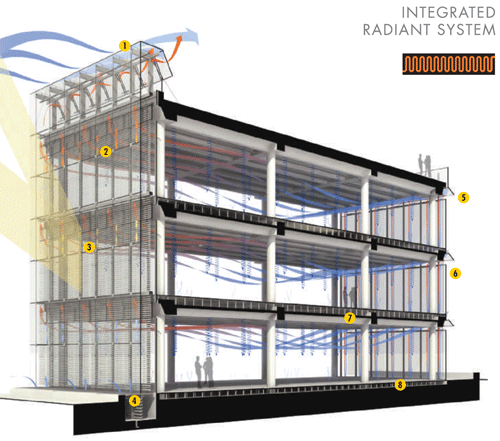Some Like It Radiant
Although examples of both convection and radiant heat transfer can be found in historic structures around the world, convective forced-air systems became the dominant method to both temper and ventilate buildings in the beginning of the 20th century, explains architect Kiel Moe in his new book Thermally Active Surfaces in Architecture. Tying temperature and ventilation together in a well-advertised product may make made good business sense for a handful of entrepreneurs, but the commercial venture had the unfortunate effect of institutionalizing into the construction industry a less efficient method of heat transfer. After all, water (the typical medium of radiant systems) can transport much more thermal energy per unit of volume than air (the typical medium of convective systems). In addition, because ventilation is decoupled from thermal conditioning in a radiant system, much less air needs to be supplied to occupied spaces, thus reducing the total amount of fan power required to move it throughout the building.
Loyola University Information Commons Architect Solomon Cordwell Buenz |
 |
This project is a good example of an integrated radiant system with radiant slabs, under-floor air, and operable windows featuring double- and single-skin curtain walls. 1 Operable windows exhaust hot air from the cavity Published as a case study in GreenSource, November/December 2008, p. 128. Illustration: Solomon Cordwell Buenz (SCB) Architecture |
Â
The earliest type of radiant system in the United States was a poured-in-place concrete floor with embedded copper piping that circulated warm water to heat the space above. Primarily installed in residential construction, it had a limited following for decades, largely due to well-founded fears of pipe failures. Radiant floor heating became more popular in the late 1980s once a relatively new type of plastic tubing called PEX became widely available.
Radiant cooling has taken longer to catch on, in part because humidity will condense on cool surfaces. Thanks to more airtight building envelopes and the development of direct outside air systems (DOAS), which manage indoor humidity while providing fresh air, radiant cooling has also become a viable option, although still much less common than heating in the United States.
Erik Olsen, PE, managing director of Transsolar's New York office, explains that, whether for heating or cooling, radiant technology takes many forms today. Hydronic tubing can be either embedded or attached to different types of floor or ceiling assemblies and can be fitted into metal or gypsum ceiling panels suspended from the structural ceiling.
Designed and installed properly, hydronic radiant systems offer many advantages over air-based HVAC, including a higher level of thermal comfort, significant operational energy savings, and greater ease of maintenance. They also free up ceiling space, which can reduce construction costs if integrated within the initial design of the building rather than being tacked on later as an afterthought, explains John Weale, PE, of Rumsey Engineers in Oakland, Calif.
While the early concerns regarding radiant heating have largely evaporated, those unfamiliar with today's technologies still worry about condensation on the interior of a radiant-cooled building in hot, humid weather. But, contends Peter Simmonds, Ph.D., of IBE Consulting Engineers (IBECE) in Sherman Oaks, Calif., "if the building is closed, it shouldn't matter what's happening outside."
As they control moisture with a conditioned supply of outside air, engineers must make sure the temperature of the chilled water for the radiant cooling system remains a few degrees above the interior air's dew point. This requires temperature and humidity sensors at key locations. Condensation alarms that turn off a section of the system if moisture is detected also can be installed as an added safeguard.
The nature of radiant thermal transfer makes it a particularly good fit for certain program functions. Radiant heating and cooling floors, for example, are well suited to large multi-height and highly glazed circulation spaces. In such areas, electromagnetic waves emanating from the floor are not impeded by lots of furniture or partitions. During winter, heating the floor ensures that thermal energy reaches the occupants immediately instead of being quickly carried to the ceiling, as commonly occurs with forced-air systems in comparable spaces. And in summer, thermal energy delivered to the floor by the sun's rays can be removed by the cooling system before occupants start to feel the heat, although a better solution would be shading the windows to prevent that problem.
In contrast, radiant ceiling panels can be suitable in spaces that are subdivided by workstations because they provide a large, uninterrupted thermal surface from above.
The case studies that follow illustrate how three design teams have recently incorporated this "most important" but often-forgotten form of thermal energy transfer into U.S. projects in very different but effective ways.









